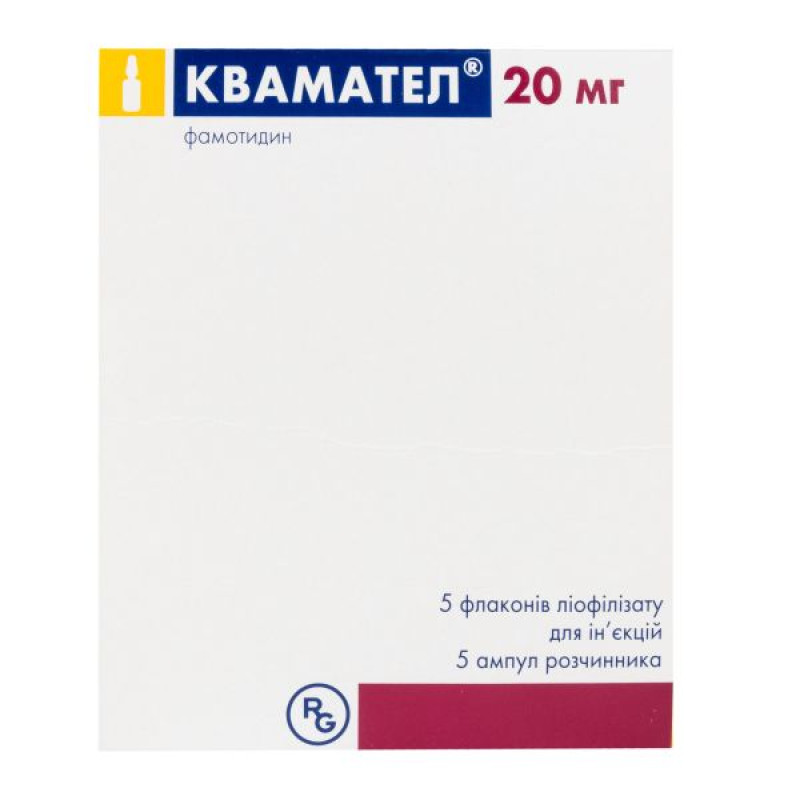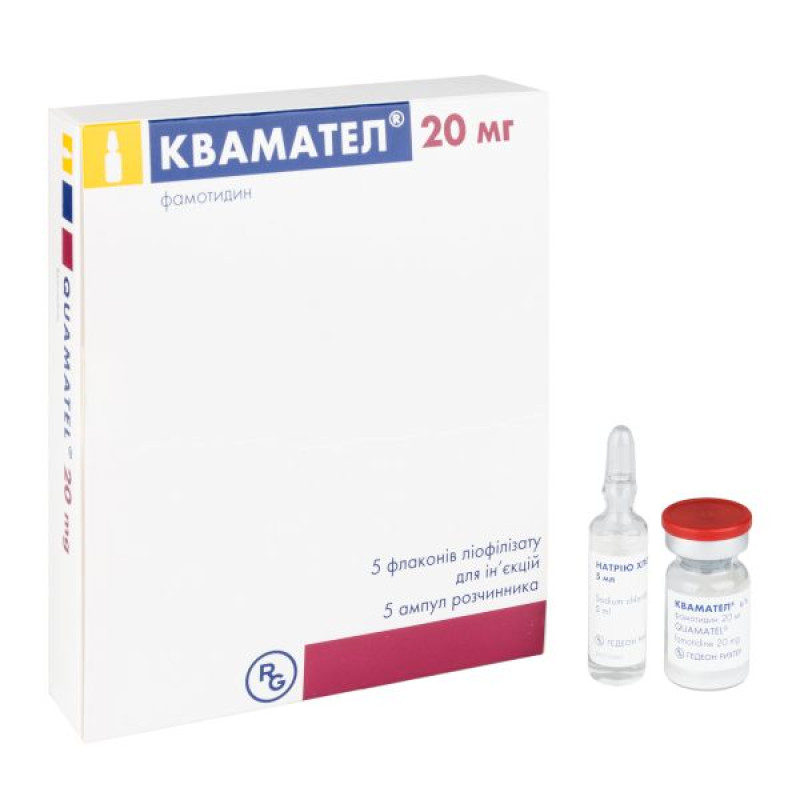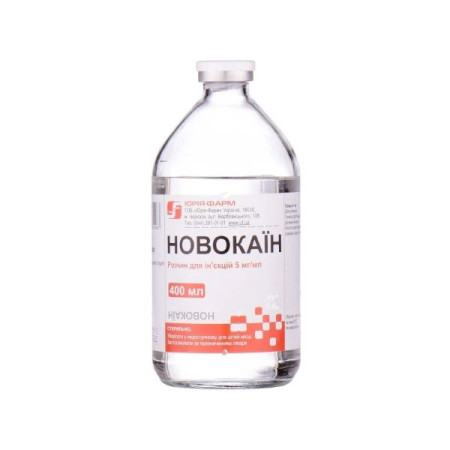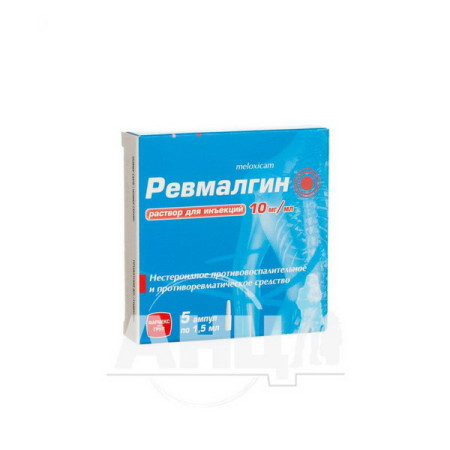Kvamatel lyophilized powder for solution for injection 20 mg vial with solvent in ampoules 5 ml No. 5
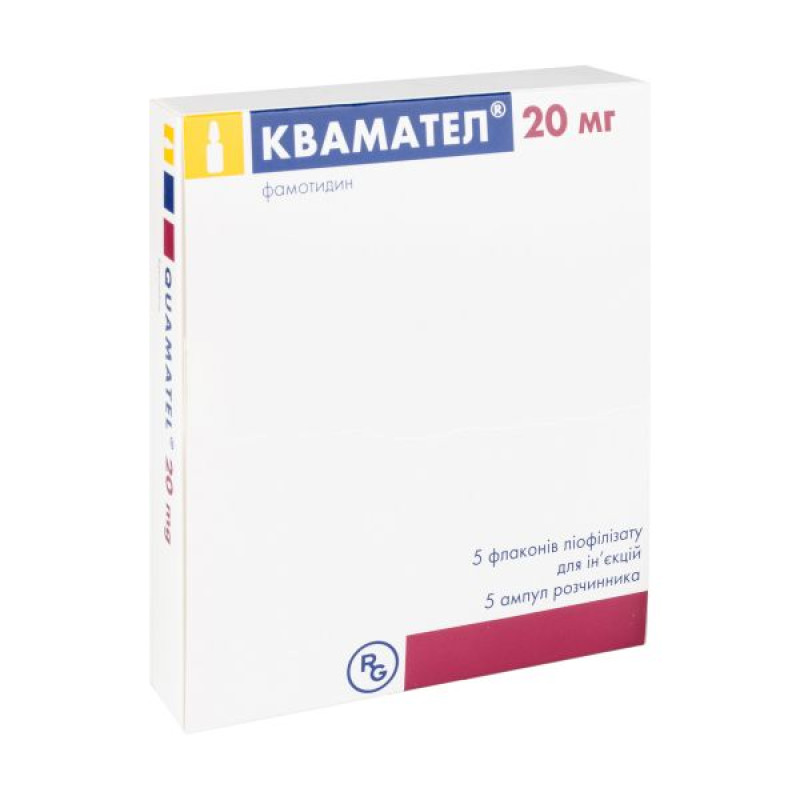
Instructions Kvamatel lyophilized powder for solution for injection 20 mg bottle with solvent in ampoules 5 ml No. 5
Composition
active ingredient: famotidine;
1 vial contains 20 mg of famotidine;
1 ampoule of solvent contains 5 ml of 0.9% sodium chloride solution;
excipients: aspartic acid, mannitol (E 421).
Dosage form
Lyophilisate for solution for injection.
Main physicochemical properties: white or almost white lyophilisate; solvent – odorless and colorless solution.
Pharmacotherapeutic group
Drugs for the treatment of peptic ulcer and gastroesophageal reflux disease. H2-receptor antagonists.
ATX code A02B A03.
Pharmacological properties
Pharmacodynamics.
Famotidine is a potent competitive inhibitor of H2-histamine receptors. The main clinically significant pharmacological action of famotidine is inhibition of gastric secretion. Famotidine reduces both the concentration of acid and the volume of gastric secretion, while pepsin production remains proportional to the volume of gastric juice secreted.
In healthy volunteers and patients with hypersecretion, famotidine inhibits basal and nocturnal gastric secretion, as well as secretion stimulated by the administration of pentagastrin, betazol, caffeine, insulin, and the physiological vagal reflex.
The duration of inhibition of secretion when using doses of 20 mg and 40 mg is from 10 to 12 hours.
Single oral doses of 20 mg and 40 mg in the evening provide inhibition of basal and nocturnal acid secretion.
Famotidine has little effect on fasting or postprandial gastrin levels.
Famotidine does not affect gastric emptying, exocrine pancreatic function, hepatic blood flow, or portal system blood flow.
Famotidine also does not affect the cytochrome P450 enzyme system of the liver.
No antiandrogenic effect of the drug was observed. Serum hormone levels did not change after treatment with famotidine.
Pharmacokinetics.
The kinetics of famotidine are linear.
Distribution: Binding to plasma proteins is relatively weak – 15-20%.
Half-life: 2.3-3.5 hours. In patients with severe renal insufficiency, the half-life of famotidine may exceed 20 hours (see section "Method of administration and dosage").
Metabolism: The drug is metabolized in the liver. The only metabolite identified in humans is the sulfoxide.
Excretion. Famotidine is excreted by the kidneys (65-70%), 30-35% of the administered drug is metabolized. Renal clearance is 250-450 ml/min, indicating some degree of tubular secretion. 65-70% of an intravenously administered dose is found in the urine unchanged. A small amount of the administered dose may be excreted as the sulfoxide.
Indication
Benign stomach ulcer.
Peptic ulcer of the duodenum.
Hypersecretory conditions such as Zollinger-Ellison syndrome.
Treatment of gastroesophageal reflux disease.
Prevention of aspiration of acidic gastric contents (Mendelssohn's syndrome) during general anesthesia.
Contraindication
Hypersensitivity to the active substance, to any of the excipients of the drug and to other H2-histamine receptor antagonists.
Children's age; pregnancy or breastfeeding (due to lack of necessary clinical experience).
Interaction with other medicinal products and other types of interactions
The absorption of certain drugs (e.g. ketoconazole, amoxicillin, iron preparations) depends on gastric acidity. Therefore, famotidine should be taken at least 2 hours after taking such drugs.
Concomitant use with other H2-receptor antagonists may significantly reduce the effectiveness of tolazoline. Although there are no confirmed interactions between famotidine and tolazoline, the likelihood of their existence is quite high, so the effect of tolazoline should be checked at the beginning and after the end of concomitant treatment. In case of a decrease in the effect of tolazoline, its dose should be gradually increased or treatment with famotidine should be discontinued.
Food and antacids have no significant effect on famotidine treatment.
There is a risk of loss of effectiveness of calcium carbonate, used for phosphate binding in hemodialysis patients, when administered simultaneously with famotidine.
Famotidine does not affect the hepatic cytochrome P450 oxidase system, so the metabolism of oral anticoagulants, antipyrine, aminopyrine, theophylline, phenytoin, diazepam, ethanol, and propranolol remains unchanged.
Probenecid may slow the release of famotidine.
Concomitant use of famotidine with tyrosine kinase inhibitors (TKIs) such as dasatinib, erlotinib, gefitinib, pazopanib may result in decreased TKI plasma concentrations and, consequently, reduced efficacy, therefore, concomitant use of famotidine with these TKIs is not recommended. For further additional recommendations, please refer to the Summary of Product Characteristics of the individual TKI-containing medicinal products.
Application features
Before starting treatment with Kvamatel®, it is necessary to exclude the presence of malignant neoplasms in the stomach and duodenum. Treatment with this drug may mask the symptoms of gastric carcinoma.
If the patient has liver failure, Kvamatel® should be used with caution and in low doses.
Since cross-sensitivity between H2-receptor antagonists has been reported, the use of Kvamatel® in patients with hypersensitivity to other H2-receptor antagonists is contraindicated.
Treatment with Kvamatel® cannot be carried out without a doctor's prescription or without a proper medical examination if:
the patient suffers from kidney or liver disease. Elderly patients or patients with impaired liver or kidney function may experience mental disorders (confusion), requiring a dose reduction;
the patient suffers from concomitant diseases or uses other medications at the same time;
a middle-aged or elderly patient has first-time complaints of digestive disorders or previous complaints have changed;
the patient has complaints about the stomach and has lost weight;
black stools appeared;
the patient has swallowing disorders or chronic abdominal pain.
The drug should be used with caution in case of acute porphyria (including a history) and immunodeficiency.
Symptoms of duodenal ulcer may resolve within 1-2 weeks, but treatment should be continued until scarring is confirmed by endoscopic or X-ray examination.
Regular monitoring of the condition of patients (especially elderly patients and patients with a history of gastric and/or duodenal ulcer) who use the drug in combination with nonsteroidal anti-inflammatory drugs is necessary.
In the case of complex treatment with antacids, the interval between the use of the drug and antacids should be at least 1-2 hours.
If a dose is missed, it should be taken as soon as possible; do not double the dose if it is almost time for the next dose.
Treatment with the drug should not be started without prior appropriate medical examination in the presence of heartburn, manifestations of hyperacidity, stomach pain, or hyperacidity after eating in elderly patients.
This medicinal product contains 18 mg sodium per dose (5 ml of solvent contains 0.9% sodium chloride), equivalent to 0.9% of the WHO recommended maximum daily intake of sodium for an adult (2 g). This medicinal product contains less than 1 mmol sodium (23 mg) per 5 ml dose, i.e. essentially sodium-free.
Use during pregnancy or breastfeeding
Fertility
In studies in rats and rabbits, famotidine was administered orally at doses up to 2000 and 500 mg/kg body weight per day, respectively, without evidence of impaired reproductive function. However, there are no good and well-controlled studies in pregnant women.
Pregnancy
Pregnancy safety category B.
Famotidine crosses the placenta. Reliable and well-controlled studies in humans have not been conducted.
The use of Kvamatel® during pregnancy is contraindicated (see section "Contraindications").
Breastfeeding period
Famotidine passes into human breast milk, therefore breastfeeding should be discontinued during use of Kvamatel®.
The use of Kvamatel® during breastfeeding is contraindicated (see section "Contraindications").
Ability to influence reaction speed when driving vehicles or other mechanisms
Patients should be careful when performing potentially hazardous activities that require increased attention and speed of psychomotor reactions, as this drug may cause dizziness.
Method of administration and doses
Doses
Kvamatel®, lyophilisate for solution for injection, can only be used in a hospital setting and in patients who cannot take the drug orally. As soon as possible, you should switch to Kvamatel® tablets.
The usual dose of Kvamatel®, lyophilisate for solution for injection, is 20 mg 2 times a day (every 12 hours).
Zollinger-Ellison syndrome
The initial dose is 20 mg (every 6 hours) and may be increased depending on the secretion of hydrochloric acid and the clinical condition of the patient.
To prevent aspiration of gastric juice during general anesthesia
20 mg intravenously on the morning of surgery or at least 2 hours before surgery.
A single dose for intravenous administration should not exceed 20 mg.
Due to the fact that famotidine is excreted mainly by the kidneys, the drug should be used with caution in severe renal failure.
If creatinine clearance is < 30 ml/min and serum creatinine is > 3 mg/100 ml, the daily dose of the drug should be reduced to 20 mg or the interval between individual doses of the drug should be increased to 36-48 hours.
Cardiovascular diseases
It is necessary to give preference to a long-term drip infusion.
Application in pediatric practice
The safety and efficacy of the drug in children have not been established. The use of Kvamatel®, lyophilisate for solution for injection, is contraindicated in children and adolescents (see section "Contraindications").
Old age
There is no need to change the dose of the drug depending on age.
Method of application
Kvamatel®, lyophilisate for solution for injection, is intended for intravenous administration only.
For intravenous administration, the contents of the vial should be dissolved in 5-10 ml of 0.9% sodium chloride solution (solvent ampoule). The diluted solution is stable for 24 hours at room temperature. The diluted solution should be administered slowly (over 2 minutes).
When used as an intravenous drip infusion, the solution should be administered over 15-30 minutes. According to incompatibility studies, the following infusion solutions can be used:
| Solution for infusion | Shelf life of diluted solution (hours) |
| Glucose solution with potassium | |
| Sodium lactate solution | 4 |
| Glucose solution 5% | 5 |
| Ringer's solution | |
| Ringer's solution with lactic acid | 8 |
| Salsol A (0.9% sodium chloride solution) |
The drug solution must be prepared immediately before use. Only a clear, colorless solution can be used.
Children.
The safety and effectiveness of the drug in children have not been established.
Overdose
When famotidine was used for a year at a dose of 800 mg per day in patients with pathological hypersecretion syndrome, no serious side effects were detected.
Treatment: symptomatic and supportive therapy, monitoring of the patient's condition.
Side effects
The following adverse events have been described as isolated or rare. However, in many cases a causal relationship to famotidine therapy has not been established.
| Organ systems | Adverse reactions |
| Hematological disorders | agranulocytosis; leukopenia; pancytopenia; thrombocytopenia; neutropenia |
| On the part of the immune system | anaphylaxis; |
| Metabolism and nutrition | anorexia |
| Mental disorders | depression; hallucinations; excitation; anxiety; confusion of consciousness; anorexia; insomnia; decreased libido |
| Neurological disorders | headache; dizziness; drowsiness; dysgeusia; cramps; paresthesia; imbalance |
| On the part of the organs of hearing and balance | tingle |
| From the organs of vision | conjunctival irritation; eye swelling |
| From the heart | arrhythmia; bradycardia; tachycardia; feeling of heartbeat; atrioventricular block |
| From the vascular side | lowering blood pressure |
| Respiratory, thoracic and mediastinal disorders | bronchospasm |
| Gastrointestinal tract | diarrhea; constipation; feeling of discomfort in the stomach; flatulence; abdominal pain; nausea; vomiting; dry mouth; acute pancreatitis |
| Hepatobiliary system | cholestatic jaundice; hepatitis |
| Skin and subcutaneous tissue disorders | acne; alopecia; angioedema; dry skin; toxic epidermal necrolysis; xeroderma; hives; itch; severe skin reactions (Stevens-Johnson syndrome, exfoliative dermatitis, erythema) |
| Musculoskeletal and connective tissue disorders | arthralgia; muscle spasms; myalgia |
| From the reproductive system and mammary glands | gynecomastia*; impotence |
| General disorders and administration site conditions | increased fatigue; mild fever |
| Abnormalities detected during laboratory examination | abnormal liver enzyme levels |
* Gynecomastia is very rare and reversible after discontinuation of treatment.
Reporting of suspected adverse reactions
Reporting of suspected adverse drug reactions after the marketing authorisation of a medicinal product is very important. It allows monitoring of the benefit-risk balance of the medicinal product. Healthcare professionals are asked to report any suspected adverse reactions via national registries.
Expiration date
2 years.
Storage conditions
Store at a temperature not exceeding 25 °C in the original packaging to protect from light. Keep out of the reach of children.
Packaging
5 vials of lyophilisate for solution for injection with 5 ampoules of solvent in a cardboard box.
Vacation category
According to the recipe.
Producer
Gedeon Richter OJSC, Hungary.
Address
H-1103, Budapest, Demrei Street 19-21, Hungary.
There are no reviews for this product.
There are no reviews for this product, be the first to leave your review.
No questions about this product, be the first and ask your question.







